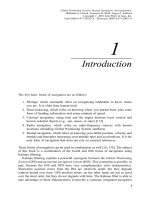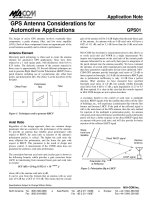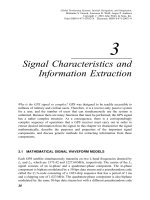Preston gps project report
Bạn đang xem bản rút gọn của tài liệu. Xem và tải ngay bản đầy đủ của tài liệu tại đây (1010.79 KB, 55 trang )
1
PRESTON UNIVERSITY
(KARACHI)
CERTIFICATE
This is to certify that the following students:
Name of students Roll No.
1. SYED MASOOD HUSAIN 23D2-211003
2.SYED NAWAID ALI
3.DANISH WAQAR
Of FINAL Year B.TECH Course in ELECTRONICS
TECHNOLOGY have successfully completed their
project work on GPS NAVIGATION.
(GPS POSITIONING SYSTEM)
In the partial fulfillment of requirement
as prescribed by the PRESTON UNIVERSITY, in
the year 2011-2012.
Prof. MATLOOB
Department of ELECTRONICS
PRESTON UNIVERSITY,(MALIR)
INTERNAL EXTERNAL
EXAMINER EXAMINER
2
ACKNOWLEDGEMENT
Our first experience of project has been successfully,
thanks to the support staff of many friends & colleagues with
gratitude. We wish to acknowledge all of them. However, we
wish to make special mention of the following.
First of all we are thankful of our project guide Sir
Matloob under whose guideline we were able to complete our
project. We are wholeheartedly thankful to him for giving us his
value able time & attention & co-operation & assistance in
solving technical problems.
And thanks to all lab maintenance staff for proving us
assistance in various hardware & software problems
encountered during course of our project.
We are also very thankful to respective principal (NAME)
sir who gave us an opportunity to present this project.
Participants
3
INDEX
SERIAL
NO.
CHAPTER NAME
PAGE
NO.
1.
2.
3.
4.
5.
INTRODUCTION
Introduction to Project
Introduction to GPS
Introduction to Circuit
Introduction to Languages
Programming steps
GPS CIRCUIT
DESCRIPTION
CIRCUIT DIAGRAM
C PROGRAM (ON-BOARD)
VISUAL BASIC PROGRAM
FEASIBILITY
Time Feasibility
Software Availability
Cost Effective
FUTURE DEVELOPMENT
Application Of Project
Future Development Of Project
BIBLIOGRAPHY
Data sheets
89C51
LCD
MAX232
HEX INVERTOR
GPS MODULE
5- 19
20- 45
46- 47
48- 49
50- 90
4
5
Chapter 1
INTRODUCTION
6
INTRODUCTION OF PROJECT
NEED OF PROJECT
As Pakistan rapidly moving toward evolution of
mechanism, So as to meet the basic necessity we needs to travel
from one place to another & sometimes to an unknown locations
otherwise we get lost. GPS Positioning system is the answer to
that.
GPS has endless uses in Clock synchronization,
Cellular telephony, Disaster relief/emergency services,
Geofencing, Vehicle tracking systems, person tracking systems,
Geotagging, GPS Aircraft Tracking, Map-making, Navigation,
Robotics etc.
GPS is a very necessary device in the field of
navigation and positioning.
7
INTRODUCTION TO GPS ( GLOBAL
POSTIONING SYSTEM)
Global Positioning System
The Global Positioning System (GPS) is a space-based
satellite navigation system that provides location and time
information in all weather, anywhere on or near the Earth, where
there is an unobstructed line of sight to four or more GPS
satellites.
The GPS program provides critical capabilities to military,
civil and commercial users around the world. In addition, GPS is
the backbone for modernizing the global air traffic system.
8
Basic concept of GPS
A GPS receiver calculates its position by precisely timing
the signals sent by GPS satellites high above the Earth. Each
satellite continually transmits messages that include
the time the message was transmitted
satellite position at time of message transmission
The receiver uses the messages it receives to determine
the transit time of each message and computes the distance to
each satellite. These distances along with the satellites'
locations are used with the possible aid of trilateration,
depending on which algorithm is used, to compute the position
of the receiver. This position is then displayed, perhaps with a
moving map display or latitude and longitude; elevation
information may be included. Many GPS units show derived
information such as direction and speed, calculated from
position changes.
Three satellites might seem enough to solve for position
since space has three dimensions and a position near the
Earth's surface can be assumed. However, even a very small
clock error multiplied by the very large speed of light. The
speed at which satellite signals propagates results in a large
positional error. Therefore receivers use four or more satellites
to solve for both the receiver's location and time. The very
accurately computed time is effectively hidden by most GPS
applications, which use only the location. A few specialized GPS
applications do however use the time; these include time
transfer, traffic signal timing, and synchronization of cell phone
base stations.
9
Although four satellites are required for normal
operation, fewer apply in special cases. If one variable is
already known, a receiver can determine its position using only
three satellites. For example, a ship or aircraft may have known
elevation. Some GPS receivers may use additional clues or
assumptions (such as reusing the last known altitude, dead
reckoning, inertial navigation, or including information from the
vehicle computer) to give a less accurate (degraded) position
when fewer than four satellites are visible.
Structure
The current GPS consists of three major segments. These
are the space segment (SS), a control segment (CS), and a user
segment (US). The U.S. Air Force develops, maintains, and
operates the space and control segments. GPS satellites
broadcast signals from space, and each GPS receiver uses these
signals to calculate its three-dimensional location (latitude,
longitude, and altitude) and the current time.
The space segment is composed of 24 to 32 satellites in
medium Earth orbit and also includes the payload adapters to
the boosters required to launch them into orbit. The control
segment is composed of a master control station, an alternate
master control station, and a host of dedicated and shared
ground antennas and monitor stations.
The user segment is composed of hundreds of thousands
of U.S. and allied military users of the secure GPS Precise
Positioning Service, and tens of millions of civil, commercial,
and scientific users of the Standard Positioning Service
10
Space segment
The space segment (SS) is composed of the orbiting GPS
satellites. The GPS design originally called for 24 SVs, six orbital
planes with four satellites each. The orbits are arranged so that
at least six satellites are always within line of sight from almost
everywhere on Earth's surface.
The result of this objective is
that the four satellites are not evenly spaced (90 degrees) apart
within each orbit. In general terms, the angular difference
between satellites in each orbit is 30, 105, 120, and 105
degrees apart which, of course, sum to 360 degrees.
Orbiting at an altitude of approximately 20,200 km (12,600 mi);
orbital radius of approximately 26,600 km (16,500 mi)
Control segment
The control segment is composed of
1. a master control station (MCS),
2. an alternate master control station,
3. four dedicated ground antennas and
4. six dedicated monitor stations
11
User segment
In general, GPS receivers are composed of an antenna,
tuned to the frequencies transmitted by the satellites, receiver-
processors, and a highly stable clock (often a crystal oscillator).
They may also include a display for providing location and
speed information to the user. A receiver is often described by
its number of channels: this signifies how many satellites it can
monitor simultaneously, receivers typically have between 12
and 20 channels. Receivers can interface with other devices
using methods including a serial connection, USB, or Bluetooth.
Applications
GPS has become a widely deployed and useful tool for
commerce, scientific uses, tracking, and surveillance. GPS's
accurate time facilitates everyday activities such as banking,
mobile phone operations, and even the control of power grids
by allowing well synchronized hand-off switching. Civilian
applications use one or more of GPS's three basic components:
absolute location, relative movement, and time transfer. Some
uses are given below:
1) Clock synchronization
2) Cellular telephony
3) Disaster relief/emergency services
4) GPS Aircraft Tracking
5) Navigation
6) Robotics
7) Vehicle tracking systems, person tracking systems etc
12
Satellite frequencies
All satellites broadcast at the same two frequencies,
1.57542 GHz (L1 signal) and 1.2276 GHz (L2 signal). GPS
frequency overview is given below:
13
A visual example of the GPS constellation in motion with
the Earth rotating:
GPS STATELLITES AROUND THE EARTH
14
Introduction to Languages
We are using two programming languages in this project:
1. Embedded C
2. Visual Basic
C Language:
C is an imperative (procedural) systems implementation
language. It was designed to be compiled using a relatively
straightforward compiler, to provide low-level access to
memory, to provide language constructs that map efficiently to
machine instructions, and to require minimal run-time support.
C was therefore useful for many applications that had formerly
been coded in assembly language.
Despite its low-level capabilities, the language was
designed to encourage cross-platform programming. A
standards-compliant and portably written C program can be
compiled for a very wide variety of computer platforms and
operating systems with few changes to its source code. The
language has become available on a very wide range of
platforms, from embedded microcontrollers to supercomputers.
C is one of the most widely used programming languages
of all time and there are very few computer architectures for
which a C compiler does not exist. C has greatly influenced
many other popular programming languages, most notably C++,
which began as an extension to C.
15
Visual Basic:
Visual Basic (VB) is a third-generation event-driven
programming language and integrated development
environment (IDE) from Microsoft for its COM programming
model first released in 1991. Visual Basic is designed to be
relatively easy to learn and use. Visual Basic was derived from
BASIC and enables the rapid application development (RAD) of
graphical user interface (GUI) applications, access to databases
using Data Access Objects, Remote Data Objects, or ActiveX
Data Objects, and creation of ActiveX controls and objects.
Scripting languages such as VBA and VBScript are syntactically
similar to Visual Basic, but perform differently.
A programmer can put together an application using the
components provided with Visual Basic itself. Programs written
in Visual Basic can also use the Windows API, but doing so
requires external function declarations. Though the program has
received criticism for its perceived faults, from version 3 Visual
Basic was a runaway commercial success, and many companies
offered third party controls greatly extending its functionality.
The final release was version 6 in 1998. Microsoft's
extended support ended in March 2008 and the designated
successor was Visual Basic .NET (now known simply as Visual
Basic).
16
The Programming Process:
The C language is used to program microcontroller that is
89c51 to display data of GPS on LCD and to transmit data on
serial port. Display data includes longitude, latitude, time,
altitude( from sea level), number of satellites locked. The
acquisition of GPS data is at 1 Hz, while the baud rate is set at
9600.
MICROCONTOLLER PROGRAMMING:
GPS provides a lot of geographical information for a
particular object like its latitude, longitude, direction of travel,
GMT etc. This information is assembled in a particular string
format which is to be decoded by GPS modems. A GPS modem
gives the output data in a following string format called as
NMEA Format. A common GPS sentence ($GPGGA) has been
explained below.
$GPGGA,100156.000,2650.9416,N,07547.8441,E,1,08,1.0,442
.8,M,-42.5,M,,0000*71
1. A string always starts with a ‘$’ sign
2. GPGGA : Global Positioning System Fix Data
3. ‘,’ Comma indicates the separation between two values
4. 100156.000 : GMT time as 10(hr):01(min):56(sec):000(ms)
17
5. 2650.9416,N: Latitude 26(degree) 50(minutes) 9416(sec)
North
6. 07547.8441,E: Longitude 075(degree) 47(minutes) 8441(sec)
East
7. 1 : Fix Quantity 0= invalid data, 1= valid data, 2=DGPS fix
8. 08 : Number of satellites currently viewed.
9. 1.0: HDOP
10. 442.8,M : Altitude (Height above sea level in meter)
11. -42.5,M : Geoids height
12. __ , DGPS data
13. 0000 : DGPS data
14. *71 : checksum
The main objective here is to find the location of the GPS
Receiver in terms of latitude and longitude. The GPS module
gives output data in RS232 logic level format. The latitude and
longitude data has been displayed on a16x2 LCD interfaced to
microcontroller.
Programming steps:
1. Set the baud rate of microcontroller USART to 9600 bps.
2. Enable the SPEN and CREN bits (RCSTA register).
18
3. Receive the Serial data and compare with the string
‘$GPGGA,’ byte by byte.
4. Wait for comma (,) as string gets matched.
5. Store the data which appears after the above comma into a
string which will be the Latitude.
6. After another comma (,), store the data into another string
which will be the Longitude.
7. After another comma (,), store the data into another string
which will be the Altitude.
8. After another comma (,), store the data into another string
which will be the Time.
9. After another comma (,), store the data into another string
which will be the Satellite lock.
10. Display Latitude, Longitude, altitude, time and satellite lock
data on LCD.
11. Repeat the steps 3 to 9 to update the GPS module’s positions
on LCD.
WINDOWS PROGRAMING:
While the Visual Basic is used to acquire ( save and
compile) GPS data from computer’s serial port. GPS saved data
is formatted in such a way that it can be loaded in GOOGLE
EARTH. The GPS data is also displayed on computer screen
using GUI ( graphical user interface). Time displayed in 12
hours clock PST format. Google earth is a navigation software
use internet connection to display satellite imaginary and maps.
19
The real time data is acquired using this project ( circuit).
Programming steps:
1. Set the baud rate of computer serial port to 9600 bps.
2. Receive the Serial data and compare with the string
‘$GPGGA,’ byte by byte.
3. Wait for comma (,) as string gets matched.
4. Make GUI for display on computer screen.
5. Time conversation from UTC to PST and in 12 hour clock.
6. Wait for comma (,) as string gets matched.
7. Save the acquired file in notepad as well as Google Earth
executable file.
20
Chapter 2
GPS CIRCUIT
21
DESCRIPTION OF GPS CIRCUIT:
The GPS module continuously transmits serial data (RS232
protocol) in the form of sentences according to NMEA standards. The
latitude and longitude values of the location are contained in the GPGGA
sentence (refer NMEA format). In this program, these values are
extracted from the GPGGA sentence and are displayed on LCD.
The serial data is taken from the GPS module through MAX232
into the SBUF register of 8051 controller (refer serial interfacing with
8051). The serial data from the GPS receiver is taken by using the Serial
Interrupt of the controller. This data consists of a sequence of NMEA
sentences from which GPGGA sentence is identified and processed.
The extraction of location values is done as follows. The first six
bytes of the data received are compared with the pre-stored ($GPGGA)
string and if matched then only data is further accounted for; otherwise
the process is repeated again. From the comma delimited GPGGA
sentence, latitude and longitude positions are extracted by finding the
respective comma positions and extracting the data. The latitude and
longitude positions extracted are displayed on the LCD interfaced with
AT89C51.
The circuit connections are as follows:
1) Receiver1 (R1) of MAX232 has been used for the serial
communication. The receiver pin of GPS module is connected to
R1IN (pin13) of MAX232. R1OUT (pin 12) of MAX232 is
connected to RxD (P3.0) of AT89C51.
2) Pins 1-3 of port P1 (P1.0, P1.1 & P1.2 respectively) of AT89C51
are connected to the control pins (RS, R/W& EN) of LCD.
3) The data pins of LCD are connected to Port P2 of the controller.
22
4) The latitude and longitude positions are displayed on the LCD.
SUMMERY:
GPS has become an efficient tool in the field of scientific use,
commerce, surveillance and tracking. This project presents a small
application based on Global Positioning System. It depicts the use of GPS
module/receiver to find latitude and longitude of its location. The data
obtained from GPS receiver (GPGGA sentence) is processed by the
microcontroller to extract its latitude and longitude values. The GPS
Module has been interfaced with AT89C51 and the location values are
displayed on a 16x2 LCD interface.
CIRCUIT DIAGRAM OF GPS POSITIONING CIRCUIT
23
MICROCONTROLLER (8051) PROGRAMING:
#include<reg51.h>
#define port2 P2
sbit rs = P1^0;
sbit rw = P1^1;
sbit e = P1^2;
char info[70];
char test[6]={"$GPGGA"};
char comma_position[15];
unsigned int check=0,i;
unsigned char a;
void receive_data();
void lcd_preston();
void lcd_satellite();
void lcd_time();
void lcd_latitude();
void lcd_longitude();
void lcd_altitude();
//DELAY FUNCTION
void delay(unsigned int msec)
{
int i,j ;
for(i=0;i<msec;i++)
for(j=0;j<1275;j++);
}
24
// LCD COMMAND SENDING FUNCTION
void lcd_cmd(unsigned char item)
{
port2 = item;
rs= 0;
rw=0;
e=1;
delay(1);
e=0;
return;
}
// LCD DATA SENDING FUNCTION
void lcd_data(unsigned char item)
{
port2 = item;
rs= 1;
rw=0;
e=1;
delay(1);
e=0;
return;
}
25
// LCD STRING SENDING FUNCTION
void lcd_string(unsigned char *str)
{
int i=0;
while(str[i]!='\0')
{
lcd_data(str[i]);
i++;
delay(10);
}
return;
}
// SERIAL PORT SETTING
void serial()
{
TMOD=0x20; //MODE=2
TH1=0xfd; // 9600 BAUD Rate
SCON=0x50; // SERIAL MODE 1 ,8- BIT DATA ,1 STOP
BIT ,1 START BIT , RECEIVING ON
TR1=1; //TIMER START
}









